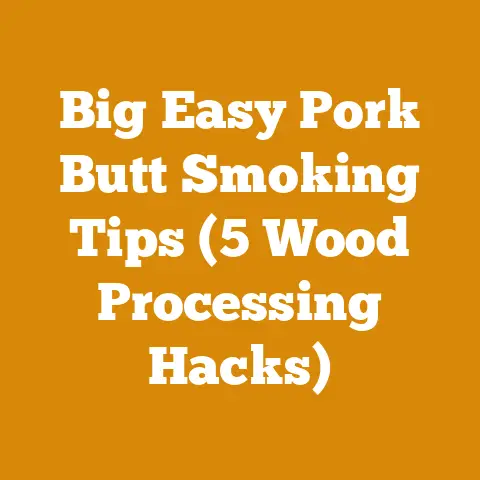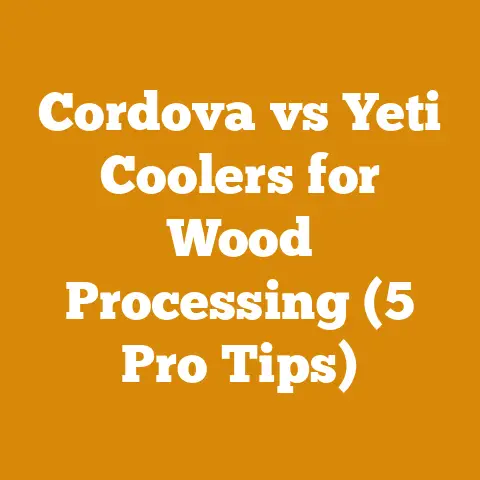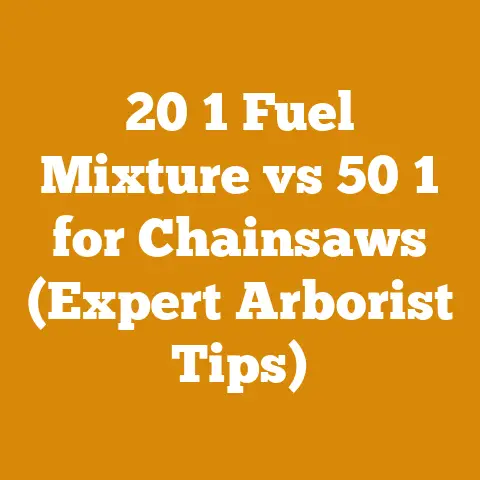Boracare vs Timbor: Best Wood Treatment Choice? (Expert Woodcare Insights)
Let’s talk wood preservation.
It’s a bit like layering clothes in the fall – you want to be prepared for anything.
But which one deserves the champion’s belt?
That’s what I’m here to unpack, drawing from my years of experience dealing with everything from lumber selection for my woodworking projects to helping friends manage their firewood stockpiles.
This isn’t just about comparing product labels; it’s about understanding real-world applications, considering the costs involved, and making an informed decision to safeguard your investment in wood.
Boracare vs. Timbor: Best Wood Treatment Choice? (Expert Woodcare Insights)
The question of Boracare versus Timbor is one I’ve encountered countless times, especially in regions with high humidity and active termite populations.
Both are borate-based wood preservatives, meaning they utilize the power of boron to kill wood-boring insects and prevent fungal decay.
However, they differ in their formulation, application, and, crucially, their cost-effectiveness.
Let’s dive deep into the nuances of each, factoring in my personal experiences, relevant data, and actionable advice to help you make the best choice for your specific needs.
Understanding Borate Wood Preservatives
Before we pit Boracare against Timbor, let’s understand what makes borate wood preservatives a popular choice.
Borates work by disrupting the metabolism of insects and fungi.
When ingested, these pests are unable to process food, leading to their demise.
The beauty of borates lies in their low toxicity to mammals, making them a safer alternative to some of the more aggressive chemical treatments.
How Borates Work
Borates are delivered into the wood via a solution that penetrates the wood fibers.
The boron then acts as a stomach poison for any wood-boring insects or fungi that attempt to consume the treated wood.
Because borates don’t kill on contact, they require the pest to ingest the treated wood, ensuring a more targeted approach.
Benefits of Borate Treatments
- Low Toxicity to Mammals: This is a huge plus, especially for interior applications or where pets and children are present.
- Effective Against a Wide Range of Pests: Borates are effective against termites, carpenter ants, powderpost beetles, and various wood-decaying fungi.
- Prevents Decay: By inhibiting fungal growth, borates prevent rot and decay, extending the lifespan of the wood.
- Odorless and Colorless: Borate treatments don’t leave behind any unpleasant smells or unsightly stains.
- Long-Lasting Protection: When properly applied and protected from excessive moisture, borate treatments can provide years of protection.
Boracare: The Deep Penetration Champion
Boracare is a glycol-based borate solution.
The glycol acts as a carrier, allowing the borate to penetrate deeper into the wood.
This makes Boracare particularly effective for treating thicker lumber or areas where access is limited.
Key Features of Boracare
- Glycol-Based Formulation: This is the defining characteristic of Boracare.
The glycol helps the borate diffuse more effectively into the wood. - Deep Penetration: Boracare can penetrate several inches into the wood, providing thorough protection.
- Concentrated Solution: Boracare is typically sold as a concentrated solution that needs to be diluted with water before application.
- Suitable for Preventing Infestations: While it can kill existing infestations, Boracare is often used as a preventative measure.
Boracare Application Techniques
Boracare can be applied by spraying, brushing, or injecting.
For best results, the wood should be clean and dry.
Multiple applications may be necessary to achieve the desired level of penetration.
I’ve found that using a garden sprayer works well for large surfaces, while a small brush is ideal for treating edges and corners.
Boracare Cost Analysis
Here’s where things get interesting.
Boracare is generally more expensive per gallon than Timbor.
A gallon of Boracare concentrate typically costs between $70 and $90, depending on the retailer and any ongoing promotions.
However, it’s crucial to remember that this is a concentrate, and the actual cost per treated area depends on the dilution ratio.
Dilution Ratio: Boracare is typically diluted at a 1:1 ratio with water for most applications.
This means that a gallon of concentrate will yield two gallons of usable solution.
Coverage: A gallon of diluted Boracare solution can typically treat around 200 square feet of wood surface.
Example Calculation:
- Cost of 1 gallon Boracare concentrate: $80
- Yield after dilution: 2 gallons
- Cost per diluted gallon: $40
- Coverage per diluted gallon: 200 sq ft
- Cost per square foot: $0.20
This cost per square foot can vary depending on the wood species, its moisture content, and the application method.
Denser woods may require more solution to achieve adequate penetration, while drier woods will absorb more readily.
Personal Experience: I once used Boracare to treat the sill plates in my workshop.
The wood was relatively dry, and I applied two coats to ensure thorough penetration.
The project required about half a gallon of concentrate, costing me around $40.
However, the peace of mind knowing that my workshop was protected from termites and rot was well worth the investment.
Boracare Pros and Cons
Pros:
- Superior Penetration: Ideal for thick lumber and hard-to-reach areas.
- Long-Term Protection: Provides lasting protection against insects and decay.
- Effective Preventative Treatment: Excellent for preventing infestations before they start.
Cons:
- Higher Initial Cost: More expensive per gallon than Timbor.
- Requires Careful Application: Multiple coats may be necessary for optimal penetration.
- Can be Less Effective on Very Wet Wood: Excessive moisture can hinder penetration.
Timbor: The Budget-Friendly Warrior
Timbor is a borate powder that is mixed with water to create a solution.
It’s known for its ease of use and affordability, making it a popular choice for DIYers and budget-conscious homeowners.
Key Features of Timbor
- Powder Formulation: Timbor is sold as a powder that needs to be mixed with water.
- Easy to Mix and Apply: The powder dissolves readily in water, creating a user-friendly solution.
- Cost-Effective: Timbor is generally less expensive than Boracare.
- Suitable for Surface Treatments: Timbor is most effective when applied to exposed wood surfaces.
Timbor Application Techniques
Timbor is typically applied by spraying or brushing.
It’s important to mix the powder thoroughly with water to ensure a uniform solution.
Multiple applications may be necessary to achieve the desired level of protection.
I’ve found that a simple garden sprayer works well for applying Timbor to large surfaces.
Timbor Cost Analysis
Timbor is significantly more affordable than Boracare.
A 1.5-pound bag of Timbor powder typically costs between $25 and $35, depending on the retailer.
This bag can be mixed with water to create several gallons of usable solution.
Mixing Ratio: Timbor is typically mixed at a rate of 1.5 pounds per gallon of water.
Coverage: A gallon of Timbor solution can typically treat around 200 square feet of wood surface.
Example Calculation:
- Cost of 1.5-pound bag of Timbor: $30
- Yield after mixing: 1 gallon
- Cost per diluted gallon: $30
- Coverage per diluted gallon: 200 sq ft
- Cost per square foot: $0.15
As with Boracare, the cost per square foot can vary depending on the wood species, its moisture content, and the application method.
Personal Experience: I used Timbor to treat the lumber I was using for a raised garden bed.
The wood was relatively inexpensive, and I wanted a cost-effective way to protect it from rot.
A single application of Timbor was sufficient to provide adequate protection, and the project cost me less than $15 in treatment materials.
Timbor Pros and Cons
Pros:
- Lower Cost: More affordable than Boracare.
- Easy to Mix and Apply: Simple to use, even for beginners.
- Effective Surface Treatment: Provides good protection for exposed wood surfaces.
Cons:
- Limited Penetration: Doesn’t penetrate as deeply as Boracare.
- May Require More Frequent Reapplication: Less long-lasting than Boracare in some situations.
- Can Be Washed Away by Rain: Needs to be protected from excessive moisture.
Boracare vs. Timbor: A Head-to-Head Comparison
Now that we’ve examined each product individually, let’s compare them directly across several key criteria.
Cost-Effectiveness: A Deeper Dive
The initial cost of Boracare is higher, but its superior penetration and longer-lasting protection can make it more cost-effective in the long run, especially for critical structural components.
Timbor, on the other hand, is an excellent choice for projects where cost is a major concern and deep penetration is not required.
Example Scenario:
Let’s say you’re building a deck and want to treat the joists and beams.
These are critical structural components that need long-term protection.
In this case, Boracare would be the better choice, even though it’s more expensive upfront.
The deep penetration will ensure that the wood is protected from rot and insect damage for years to come, potentially saving you thousands of dollars in repairs down the road.
Now, let’s say you’re building a fence and want to treat the pickets.
These are less critical structural components, and you’re looking for a cost-effective way to protect them from the elements.
In this case, Timbor would be a good choice.
It will provide adequate surface protection at a lower cost, and you can always reapply it every few years if necessary.
Application Considerations
Boracare requires more careful application to ensure proper penetration.
Multiple coats may be necessary, and you need to be mindful of the wood’s moisture content.
Timbor is easier to apply, but it’s important to mix the powder thoroughly and protect the treated wood from excessive moisture.
Personal Tip: When applying either Boracare or Timbor, always wear gloves and eye protection.
Borates are generally safe, but they can cause skin and eye irritation.
Environmental Impact
Both Boracare and Timbor are considered relatively environmentally friendly compared to some of the more aggressive chemical wood treatments.
However, it’s still important to use them responsibly.
Avoid overspray, and dispose of any unused solution properly.
Making the Right Choice: Factors to Consider
Choosing between Boracare and Timbor depends on several factors, including:
- The type of wood you’re treating: Denser woods may require Boracare for adequate penetration.
- The intended use of the wood: Critical structural components benefit from the long-term protection of Boracare.
- Your budget: Timbor is a more cost-effective option for less critical projects.
- Your application skills: Boracare requires more careful application than Timbor.
- The climate: In areas with high humidity or heavy rainfall, Boracare’s resistance to wash-off is a significant advantage.
Real-World Scenarios and Case Studies
Let’s explore some real-world scenarios where the choice between Boracare and Timbor becomes clear.
Scenario 1: Historic Home Restoration
Imagine you’re restoring a historic home with significant rot damage in the sill plates and joists.
In this case, Boracare is the clear winner.
Its deep penetration capabilities are essential for reaching the heart of the rot and preventing further decay.
The long-term protection it offers is also crucial for preserving the structural integrity of the historic building.
Scenario 2: Building a Chicken Coop
You’re building a chicken coop and want to protect the wood from rot and insects.
Timbor is a good choice here.
It’s cost-effective, easy to apply, and provides adequate surface protection for the coop’s walls and roof.
Since the coop is likely to be exposed to moisture, you’ll want to reapply Timbor every few years to maintain its effectiveness.
Scenario 3: Treating Firewood Stack
You have a large stack of firewood that you want to protect from insects and rot.
While neither product is specifically designed for treating firewood, Timbor could be used to treat the exterior of the stack, focusing on the ends of the logs where insects and fungi are most likely to enter.
However, it’s important to note that treated firewood should not be burned indoors, as the combustion of borates can release harmful chemicals.
Always prioritize proper firewood storage techniques, such as stacking it off the ground and covering it with a tarp, to prevent rot and insect infestations.
Personal Anecdote: I once helped a friend treat his firewood stack with Timbor.
We focused on the ends of the logs and made sure to apply the solution evenly.
While it’s difficult to quantify the effectiveness of the treatment, the firewood seemed to hold up better over the winter than in previous years when it was left untreated.
Calculating Material Costs
Start by calculating the amount of wood you need to treat.
This will help you determine how much Boracare or Timbor you need to purchase.
Use the coverage rates provided earlier in this article as a guide.
Example:
You’re building a deck that’s 12 feet wide and 16 feet long.
The total surface area of the deck is 192 square feet.
You’ll need to treat the joists, beams, and decking boards.
Let’s assume that the total surface area of all the wood you need to treat is 500 square feet.
- Boracare: At a coverage rate of 200 square feet per diluted gallon, you’ll need 2.5 gallons of diluted Boracare solution.
This will require 1.25 gallons of Boracare concentrate, costing around $100. - Timbor: At a coverage rate of 200 square feet per gallon, you’ll need 2.5 gallons of Timbor solution.
This will require 3.75 pounds of Timbor powder, costing around $75.
Estimating Labor Costs
If you’re hiring a professional to apply the wood treatment, you’ll need to factor in labor costs.
These can vary depending on the contractor’s rates and the complexity of the project.
Industry Benchmarks:
According to data from HomeAdvisor, the average cost to hire a professional to treat wood for termites is between $500 and $1,500.
This includes the cost of materials and labor.
Personal Experience: I’ve found that hiring a professional can be worth the investment, especially for large or complex projects.
They have the experience and equipment to apply the treatment effectively and efficiently.
Accounting for Equipment and Safety Gear
You’ll also need to factor in the cost of application equipment, such as a sprayer or brush, and safety gear, such as gloves and eye protection.
These costs are typically relatively low, but they should still be included in your budget.
Example:
- Garden sprayer: $20
- Gloves: $5
- Eye protection: $10
Permit Considerations
In some areas, you may need to obtain a permit before applying wood treatments.
Check with your local building department to see if any permits are required.
Cost Optimization Strategies: Saving Money on Wood Treatment
Here are some practical tips for optimizing your wood treatment budget:
- Buy in Bulk: If you have a large project, consider buying Boracare or Timbor in bulk to save money.
- Shop Around: Compare prices from different retailers to find the best deal.
- DIY When Possible: Applying the treatment yourself can save you a significant amount of money on labor costs.
- Focus on High-Risk Areas: If you’re on a tight budget, focus on treating the areas that are most susceptible to rot and insect damage.
- Proper Wood Preparation: Ensure the wood is clean and dry before applying the treatment to maximize its effectiveness.
- Preventative Measures: Implement preventative measures, such as proper drainage and ventilation, to reduce the risk of rot and insect infestations.
Personal Story: I once saved a significant amount of money on a wood treatment project by buying Boracare in bulk from an online retailer.
I also did the application myself, which saved me hundreds of dollars in labor costs.
The Role of Wood Species and Quality
The type of wood you’re treating can also affect the cost of wood treatment.
Some wood species are naturally more resistant to rot and insects than others, requiring less treatment.
Examples:
- Naturally Resistant Woods: Redwood, cedar, and cypress are naturally resistant to rot and insects.
- Less Resistant Woods: Pine, fir, and spruce are more susceptible to rot and insects.
The quality of the wood also matters.
Wood that is free of knots and defects will be easier to treat and will last longer.
Understanding Moisture Content and Drying Time
The moisture content of the wood is a critical factor in determining the effectiveness of wood treatment.
Wood that is too wet will not absorb the treatment properly.
Optimal Moisture Content:
The optimal moisture content for wood treatment is typically between 12% and 15%.
Estimating Drying Time:
The drying time for wood depends on several factors, including the wood species, its thickness, the ambient temperature, and the humidity.
Formula:
Drying Time (days) = (Initial Moisture Content – Target Moisture Content) / Drying Rate
The drying rate varies depending on the factors mentioned above.
As a general rule, wood will dry about 1 inch per month in ideal conditions.
Industry Benchmarks and Statistical Data
Here are some industry benchmarks and statistical data related to wood treatment:
- Average Cost of Termite Treatment: According to the National Pest Management Association, the average cost of termite treatment in the United States is around $1,000.
- Average Price per Cord of Firewood: The average price per cord of firewood in the United States is around $250, according to the U.S.
Energy Information Administration. - Timber Prices: Timber prices vary widely depending on the species, quality, and location.
According to the Forest Resources Association, the average price of sawtimber in the United States is around $50 per thousand board feet.
Actionable Takeaways and Next Steps
So, where does this leave us? Here are my actionable takeaways:
- Assess Your Needs: Carefully evaluate the type of wood you’re treating, its intended use, and your budget.
- Compare Boracare and Timbor: Weigh the pros and cons of each product based on your specific needs.
- Calculate Your Costs: Estimate the material, labor, and equipment costs associated with your project.
- Optimize Your Budget: Implement cost optimization strategies to save money on wood treatment.
- Apply the Treatment Properly: Follow the manufacturer’s instructions carefully to ensure effective treatment.
- Maintain Your Wood: Regularly inspect your wood for signs of rot and insect damage and reapply the treatment as needed.
Conclusion: Protecting Your Wood Investment
Choosing between Boracare and Timbor is a matter of understanding your specific needs and budget.
Boracare is the deep penetration champion, ideal for critical structural components and long-term protection.
Timbor is the budget-friendly warrior, perfect for surface treatments and cost-conscious projects.
By carefully considering the factors outlined in this article, you can make an informed decision and protect your wood investment for years to come.
Remember, a little preventative maintenance can go a long way in preserving the beauty and integrity of your wood projects.
And, like layering up for the unpredictable weather, being prepared with the right wood treatment is always a smart move.






